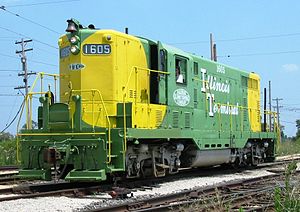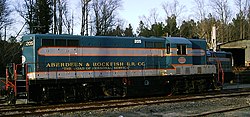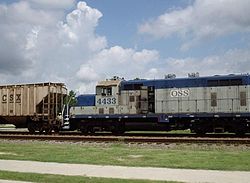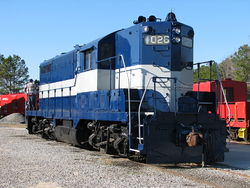EMD GP7 (original) (raw)
From Wikipedia, the free encyclopedia
Diesel-electric locomotive
| EMD GP7 |
|---|
 ITC 1605, at the Illinois Railway Museum ITC 1605, at the Illinois Railway Museum |
| Type and originPower typeDiesel-electricBuilderGeneral Motors Electro-Motive Division (EMD)General Motors Diesel (GMD)ModelGP7Build dateOctober 1949 – May 1954Total produced2,729 (plus 5 B units) |
| SpecificationsConfiguration: • AARB-BGauge4 ft 8+1⁄2 in (1,435 mm) standard gaugeWheel diameter40 in (1.016 m)[1]Minimum curve19° (301 ft (91.74 m) radius)Wheelbase40 ft (12.19 m)Length55 ft 11 in (17.04 m)Width10 ft 3 in (3.12 m)Height15 ft 0 in (4.57 m)Loco weight246,000 lb (112,000 kg)Fuel capacity1,600 US gal (6,100 L; 1,300 imp gal)[1]Lubricant cap.200 US gal (760 L; 170 imp gal)[1]Coolant cap.230 US gal (870 L; 190 imp gal)[1]Sandbox cap.18 cu ft (510 dm3)[1]Prime moverEMD 16-567B[2]RPM range275–800[1]Engine typeV16 Two-stroke dieselAspirationRoots blowerDisplacement9,072 cu in (148.66 L)GeneratorEMD D-12-B[1]Traction motors(4) EMD D-27-B[1]Cylinders16Cylinder size8+1⁄2 in × 10 in (216 mm × 254 mm)Loco brakeIndependent air; optional: dynamic brakesTrain brakesAir, schedule 6-BL[3] or 6-BLC.[4] Schedule 24-RL offered as optional. |
| Performance figuresMaximum speed65 mph (105 km/h)Power output1,500 hp (1,119 kW)Tractive effortStarting: 65,000 lbf (29,484 kgf) @25% Continuous: 40,000 lbf (18,144 kgf) @9.3 mph (15 km/h) |
| CareerOperatorsSee listClassErie- MFSE-15a NYC- various P&E- 5612-5623 DRS-4c 5624-5625 DRS-4d P&LE- various NKP- ERS-15 PRR- ERS15 WAB- D15DispositionSome retired, some rebuilt into GP8s or GP10s, many in service |
Aberdeen and Rockfish Railroad 205 at the company’s yard in Aberdeen, North Carolina
BBRR 1, a GP7, with the ODC special, Dillwyn, Virginia.
Chesapeake and Albemarle 2158 (an ex-ATSF GP7U) in Chesapeake, VA.
OmniTrax 4433 (a GP7 rebuilt by the Chicago and North Western Railway) spotted on CSX in Augusta, Georgia.
The EMD GP7 is a four-axle (B-B) diesel-electric locomotive built by General Motors Electro-Motive Division and General Motors Diesel between October 1949 and May 1954.[2]
The GP7 was the first EMD road locomotive to use a hood unit design instead of a car-body design. This proved to be more efficient than the car body design as the hood unit cost less to build, was cheaper and easier to maintain, and had much better front and rear visibility for switching.[5] Power was provided by an EMD 567B 16-cylinder engine which generated 1,500 horsepower (1,119 kW).[6] The GP7 was offered both with and without control cabs, and those built without control cabs were called a GP7B. Five GP7B's were built between March and April 1953.[2]
Of the 2,734 GP7's built, 2,620 were for American railroads (including 5 GP7B units built for the Atchison, Topeka and Santa Fe Railway), 112 were built for Canadian railroads, and 2 were built for Mexican railroads.
This was the first model in EMD's GP (General Purpose) series of locomotives. Concurrently, EMD offered a six-axle (C-C) SD (Special Duty) locomotive, the SD7.[5] The GP7 was replaced by the GP9 model in GM-EMD's GP sequence.
ALCO, Fairbanks-Morse, and Baldwin had all introduced road switchers before EMD, whose first attempt at the road-switcher, the BL2 was unsuccessful in the market, selling only 58 units in the 14 months it was in production.[7] Its replacement, the GP7, swapped the truss-framed stressed car body for an un-stressed body on a frame made from flat, formed and rolled structural steel members and steel forgings welded into a single structure (a "weldment"), a basic design which is still being employed today. In heavy service, the GP7’s frame would bow and sag over time.[8] This defect was corrected in later models.
The GP7 proved very popular, and EMD was barely able to meet demand, even after opening a second assembly plant at Cleveland, Ohio. Later, locomotives in EMD's GP-series came to be nicknamed ‘Geeps’. Many GP7s both high and short-hood can still be found in service today on shortline railroads and industrial operators. Although most Class 1 roads stopped using these locomotives by the 1980s some remain in rebuilt form on some major Class I railroads, as switcher locomotives.[_citation needed_]. The "GP" designation stood for "general purpose", while the "7" had no meaning other than matching the EMD F7 cab unit then in production.
The GP7, GP9 and GP18 locomotives share a similar car-body that evolved over time. Most GP7s had three sets of ventilation grills under the cab (where the GP9 only had one), and two pair of grills at the end of the long hood (where only the pair nearest the end was retained on the GP9).[2] However, some late GP7s were built with car-bodies that were identical to early GP9s. Early GP7s had a solid skirt above the fuel tank, while late GP7s and early GP9s had access holes in the skirt (see photo of Illinois Terminal 1605, top left). Many railroads later removed most of the skirt to improve access and inspection.
Locomotives could be built with the engineer’s control stand installed for either the long hood, or the short hood designated as the front. Two control stands for either direction running was also an option, but one end would still be designated as the front for maintenance purposes. The GP7 was also available with or without dynamic brakes, and a steam generator installed in the short hood was also an option. In the latter case, the 1,600-US-gallon (6,100 L; 1,300 imp gal) fuel tank was divided, with half for diesel fuel, and half for boiler water. One option available for locomotives without dynamic brakes, was to remove the two 22.5 in × 102 in (570 mm × 2,590 mm)[9] air reservoir tanks from under the frame, and replace them with four 12 in × 150.25 in (305 mm × 3,816 mm)[4] tanks that were installed on the roof of the locomotive, above the prime mover. These "torpedo tubes" as they were nicknamed, enabled the fuel and water tanks to be increased to 1,100 US gallons (4,200 L; 920 imp gal) each, although some railroads opted for roof-mounted air tanks and 2,200-US-gallon (8,300 L; 1,800 imp gal)[10] fuel tanks on their freight ‘Geeps’.
Locomotives built by Electro-Motive Division, USA
[edit]
| Owner | Quantity | Numbers | Notes | | | ---------------------------------------------------------------------------------------------------------------------------------------------------------------------------------------------------------------------------------------------------- | ---------------------- | ----------------------------------------------------------------------------------------------------------- | ---------------------------------------------------------------------------------------------------------------------------------------------------------------------------------------------------------------------------------------------------------------------------------------------------------------------------------------------------------------------------------------------------------------------------------------------------------------------------------------------------------------------------------------- | | | Electro-Motive Division (demonstrator) | 1 | 525 | 1350 hp GP7m; to Atchison, Topeka and Santa Fe 99, renumbered 2899[11] This unit was built with a 567BC engine. | | | 3 | 100 (ex-922), 200, 300 | to Chicago & North Western 1518–1520. 1518 first built, preserved and operating at Illinois Railway Museum | | | | Aberdeen and Rockfish Railroad | 1 | 205 | | | | Atchison, Topeka and Santa Fe | 244 | 2650–2893 | 2855-2858 were built with 567C engines | | | 5 | 2788A–2792A | GP7B; 2788A-2789A, 2791A-2792A were built with 567C engines | | | | Atlanta and St. Andrews Bay | 2 | 501–502 | | | | Atlanta and West Point Rail Road | 5 | 571–575 | | | | Atlantic and East Carolina Railway | 1 | 501 | Renumbered 406. | | | Atlantic Coast Line Railroad | 154 | 100-253 | | | | Baltimore and Ohio Railroad | 33 | 720–731, 740–746, 910–922, 6405 | 728-729; 740-746 were built with 567BC engines. Long-hood-forward | | | Bangor and Aroostook Railroad | 16 | 560–575 | | | | Belt Railway of Chicago | 8 | 470–477 | | | | Boston and Maine Railroad | 23 | 1555–1577 | | | | Butte, Anaconda and Pacific Railway | 3 | 101–103 | | | | Central of Georgia Railway | 15 | 106–107, 120–132 | | | | Central Railroad of New Jersey | 13 | 1520–1532 | | | | Atlantic Coast Line Railroad (Charleston and Western Carolina Railway) | 21 | 200–220 | To Atlantic Coast Line 254-274. | | | Chesapeake and Ohio Railway | 180 | 5700–5719, 5739–5797, 5800–5900 | 5720–5738 built by GMD | | | Chicago and Eastern Illinois Railroad | 30 | 203–232 | | | | Chicago and North Western Railway | 110 | 1521–1550, 1556–1559, 1562–1599, 1601–1603, 1625–1659 | | | | Chicago and North Western (Chicago, St. Paul, Minneapolis and Omaha Railway—"Omaha Road") | 11 | 151–161 | | | | Chicago, Burlington and Quincy Railroad | 68 | 200–267 | 253-267 were built with 567BC engines | | | Chicago Great Western Railway | 2 | 120–121 | | | | Chicago, Rock Island and Pacific Railroad | 113 | 430–441, 1200–1237, 1250–1311, 1308 (2nd) | 1294-1299 were built with 567BC engines | | | Clinchfield Railroad | 17 | 900–916 | | | | Colorado and Wyoming Railway | 2 | 103–104 | Engines 103 & 104 are owned by the Pueblo Railway Foundation. Both locomotives are operable and used occasionally on Museum grounds . | | | Colorado Fuel and Iron | 2 | 101–102 | Engine 102 is owned by the Pueblo Railway Foundation. The locomotive is operable and used occasionally on Museum grounds. | | | Atlantic Coast Line Railroad (Columbia, Newberry and Laurens Railroad) | 5 | 100–104 | To Atlantic Coast Line 275-279. | | | Delaware, Lackawanna and Western Railroad | 20 | 951–970 | To Erie Lackawanna, 1270-1284, 1405-1409. | | | Denver and Rio Grande Western Railroad | 14 | 5100–5113 | | | | Detroit and Toledo Shore Line Railroad | 10 | 41–50 | | | | Detroit, Toledo and Ironton Railroad | 24 | 950–973 | 964-973 were built with 567BC engines | | | Erie Railroad | 52 | 1200–1246, 1400–1404 | To Erie Lackawanna, same numbers. | | | Florida East Coast Railway | 15 | 607–621 | | | | Georgia and Florida Railroad | 6 | 701–706 | | | | Georgia Railroad | 16 | 1021–1036 | 1035-1036 were built with 567BC engines | | | Great Northern Railway | 56 | 600–655 | Long-hood-forward | | | Illinois Central Railroad | 48 | 8800–8801, 8850–8851, 8900–8911, 8950–8981 | 8800–8801, 8900–8911 had steam generators | | | Illinois Terminal Railroad | 6 | 1600–1605 | | | | Kansas City Southern Railway | 8 | 155–162 | | | | Kansas City Southern (Louisiana and Arkansas Railway) | 5 | 150–154 | | | | Kansas, Oklahoma and Gulf Railway | 9 | 801–809 | | | | Louisville and Nashville Railroad | 61 | 400–440, 500–514, 501–502 (2nd), 550–552 | | | | Maine Central Railroad | 19 | 561–569, 571–580 | 566-569 were built with 567BC engines | | | Meridian and Bigbee Railroad | 1 | 1 | Renumbered 101. | | | Midland Valley Railroad | 4 | 151–154 | | | | Minneapolis, St. Paul and Sault Ste. Marie Railroad ("Soo Line") | 7 | 375–378, 381–383 | | | | Missouri Pacific Railroad | 208 | 4116–4194, 4197–4325 | 4116-4120, 4159-4165, 4203-4207, 4249-4253, 4284-4286, 4323-4324 owned by St. Louis, Brownsville and Mexico, 4121-4123, 4153-4158, 4197-4202, 4254-4255, 4287-4297, 4325 owned by International-Great Northern, 4290-4291, 4316-4320, 4325 were built with 567BC engines; 4292-4315, 4321-4324 were built with 567C engines. | | | Missouri–Kansas–Texas Railroad | 33 | 1501–1529, 1761–1764 | 1700s had steam generators. Renumbered 91–123 | | | Nashville, Chattanooga and St. Louis Railway | 37 | 700–731, 750–754 | 700-705 built with EMD AAR TypeA trucks[12] | | | Ferrocarriles Nacionales de México (National Railways of Mexico) | 2 | 6600–6601 | | | | New York Central Railroad | 169 | 5600–5611, 5626-5675, 5686-5712, 5738-5817 | Long-hood-forward | | | New York Central Railroad (Peoria and Eastern Railway) | 14 | 5612-5625 | Long-hood-forward | | | New York Central Railroad (Pittsburgh and Lake Erie Railroad) | 35 | 5676-5685, 5713-5737 | Long-hood-forward | | | New York, Chicago and St. Louis Railroad ("Nickel Plate Road") | 48 | 400–447 | | | | Northern Pacific Railway | 20 | 550–569 | to Burlington Northern Railroad 1624–1643;[8] 560-569 were built with 567BC engines | | | Pennsylvania Railroad | 66 | 8500–8512, 8545–8587, 8797–8806 | Long-hood-forward | | | Phelps Dodge Corporation | 7 | 1–2, 7–8, 27–29 | | | | Portland Terminal Company [Maine] | 1 | 1081 | | | | Reading Company | 44 | 600–636, 660–666 | 625-636 were built with 567BC engines. Long-hood-forward | | | Richmond, Fredericksburg and Potomac Railroad | 4 | 101–104 | | | | Seaboard Air Line Railroad | 123 | 1700–1822 | | | | Southern Railway | 57 | 2063–2077, 2156–2197 | | | | Southern Railway (Cincinnati, New Orleans and Texas Pacific Railway) | 11 | 6200–6205, 6240–6244 | | | | Southern Railway (Alabama Great Southern Railroad) | 5 | 6540–6544 | | | | Southern Railway (Georgia Southern and Florida Railway) | 4 | 8210–8213 | | | | St. Louis Southwestern Railway | 1 | 320 | Renumbered 304. | | | St. Louis–San Francisco Railway | 129 | 500–549, 555–632, 615 (2nd) | | | | Tennessee, Alabama and Georgia Railway | 3 | 707–709 | | | | Texas and Pacific Railway | 21 | 1110–1130 | | | | Texas Mexican Railway | 3 | 850–852 | | | | Toledo, Peoria and Western Railway | 2 | 102–103 | | | | Union Pacific Railroad | 30 | 700–729 | 720-729 were built with 567BC engines | | | United States Army | 20 | 1821–1840 | Built with EMD AAR TypeA trucks; 12 later served on Alaska RR and 11 were retrucked with AAR Type B road trucks | | | Wabash Railroad | 33 | 450–452, 454–483 | 453 built by GMD | | | Western Maryland Railway | 4 | 20–23 | | | | Western Pacific Railroad | 13 | 701–713 | | | | Western Railway of Alabama | 6 | 521–526 | | | | Totals | 2617 5 | GP7GP7B | | |
Locomotives built by General Motors Diesel, Canada
[edit]
GP7 locomotives were built at GMD's London Ontario plant for domestic Canadian railway purchasers, and for some US railroads like the C&O and Wabash who owned and operated over trackage in Canada (specifically the southern Ontario area).
| Owner | Quantity | Numbers | Notes |
|---|---|---|---|
| Algoma Central and Hudson Bay | 21 | 150–170 | |
| Canadian National Railways | 25 | 4824, 7555–7578 | 4824 rebuilt October 1958 with parts from wrecked F3A. 7555-7578 renumbered to 4800-4823 mid-1957. Long-hood-forward |
| Canadian Pacific Railway | 17 | 8409–8425 | 8410-8411 originally built with steam generators |
| Chesapeake and Ohio Railway | 19 | 5720–5738 | C&O 5720-5729 resold to NYC as 5818-5827 for their Canadian operations |
| Quebec North Shore and Labrador Railway | 22 | 100–101, 104–123 | |
| Toronto, Hamilton and Buffalo Railway | 7 | 71–77 | To CP (minus wrecked 71), all rebuilt as CP 1682-1687 |
| Wabash Railroad | 1 | 453 | Later to N&W 3453 |
| Total | 112 |
Rebuilds, modifications and conversions
[edit]
There are five GP7s on A J Kristopan's EMD Serial number page that reused previous serial numbers: B&O 6405 (preserved), CRI&P 1308 (2nd), L&N 501 (2nd) and 502 (2nd), and SLSF 615 (2nd). These rebuilt units were rebuilt as new on new frames. Another rebuild by GMD is that CN 4824 was rebuilt as a GP7 with parts from an F3A in October 1958.
Over 100 GP7s and four of the GP7Bs were built with 567BC or 567C engines starting in March 1953 through May 1954. These are noted on the roster above.
Many railroads rebuilt their GP7s with low short hoods; some railroads went further in their rebuilding than others. Missouri Pacific Railroad upgraded their GP7s with 567BC engines (a B-block upgraded to C-block specs) and replaced the standard EMD 2-stack exhaust with a 4-stack "liberated" exhaust, raising their power output to 1,600 horsepower (1.19 MW).[13]
Illinois Central Railroad rebuilt most of its GP7s with 567BC engines, 4-stack exhausts, paper air-intake filters, 26-L brakes (their original 6-BL brakes made them operationally incompatible with locomotives fitted with 24-RL brakes).[14] All but the first locomotive rebuilt had their front (short) hood reduced in height for improved crew visibility. The IC designated these rebuilt locomotives GP8. The IC acquired many second-hand units through Precision National Corporation (PNC), and then started offering their GP8/GP10 rebuilding services to other railroads through their Paducah Shops (note, a rebuilt "Paducah Geep" was designated a GP8 or GP10 depending on the power output of the rebuilt engine, not necessarily what it was rebuilt from).
In 1960 the Alaska Railroad purchased a dozen GP7Ls from the US Army and rebuilt eleven of them in 1965 with low short hoods for better visual clearance. One of the ten remaining Alaska GP7s was rebuilt by Morrison-Knudsen in 1976. The other nine units were rebuilt at Paducah Shops in 1976-1977.
Canadian Pacific Railway rebuilt their GP7 fleet in the early 1980's as GP7u units for yard service, including a chopped short hood, new numberboards and front cab windows, and upgrading the 567B prime movers with 645 power assemblies and to "BC" engine block specs (some upgraded with 567C engine blocks out of retired F-units).
Georgia Railroad 1026, an EMD GP7 -- on permanent display in Duluth, Georgia.
Numerous GP7s have been preserved on tourist lines and in museums. Holders include:
- ^ a b c d e f g h Schrenk & Frey (1988) p.291
- ^ a b c d Pinkepank, Jerry A. (1973) pp. 53
- ^ IC Railroad 1969 diesel diagrams, pp.46–47
- ^ a b NP Railway diesel diagram, NP 557–558
- ^ a b Schafer, Mike (1998). Vintage diesel locomotives. Osceola, WI: Motorbooks International. p. 37. ISBN 0-7603-0507-2. OCLC 38738930.
- ^ The History of EMD Diesel Engines
- ^ Pinkepank, Jerry A. (1973) p. 51
- ^ a b Schren & Frey (1988). p.162
- ^ NP Railway diesel diagram, NP 550–551
- ^ Schrenk & Frey (1988). p.159
- ^ Pinkepank, Jerry A. (1973) p.56
- ^ "L&N 494". rrpicturearchives.net. Retrieved 2019-06-14.
- ^ Marre & Pinkepank (1988). p.192
- ^ Marre & Pinkepank (1988). p.183
- "The History of EMD Diesel Engines". Pacific Southwest Railway Museum. Archived from the original on July 22, 2014. Retrieved December 14, 2005.
- "Illinois Central Railroad 1969 locomotive diagram book". icgphotos.com. Retrieved September 2, 2008.[_permanent dead link_]
- "Northern Pacific Railway diesel locomotive diagrams". Northern Pacific Railway Historical Association website. Retrieved September 2, 2008.
- Dorin, Patrick C. (1972). Chicago and North Western Power. Burbank, California: Superior Publishing. pp. 106–107. ISBN 0-87564-715-4.
- Ephraim, Max Jr. (June 1995). "The Beloved Geep". Trains. 55 (6): 44–47. ISSN 0041-0934.
- Kristopans, A. J. "EMD 567 road switchers serial number webpage". Retrieved September 1, 2008.
- Kristopans, A. J. "General Motors Diesel Division (Canada) serial number webpage". Archived from the original on October 31, 2020. Retrieved September 1, 2008.
- http://utahrails.net/ajkristopans/GMEXPORT2_22-Sep-2015_update.txt Export GP7 serial numbers
- Marre, Louis A.; Jerry A. Pinkepank (1989). The Contemporary Diesel Spotter's Guide. Milwaukee, Wisconsin: Kalmbach Publishing Company. ISBN 0-89024-088-4.
- Pinkpank, Jerry A (1973). The Second Diesel Spotter's Guide. Kalmbach Books. pp. 12, 26, 52–56. ISBN 0-89024-026-4.
- Schrenk, Lorenz P.; Robert L. Frey (1988). Northern Pacific Railway: Diesel Era, 1945–1970. San Marino, California: Golden West Books. ISBN 0-87095-102-5.
EMD Product Reference Data Card dated January 1, 1959 has the 567BC and 567C engine data used in the as-built roster.




